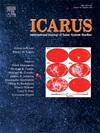Statistical evaluation of boulder spatial patterns on asteroids and application to Eros, Itokawa and Ryugu
IF 2.5
2区 物理与天体物理
Q2 ASTRONOMY & ASTROPHYSICS
引用次数: 0
Abstract
In planetary science, the statistical properties of spatial distributions are frequently examined to understand the formation and evolution of a body's surface. The surfaces of the asteroids directly explored by spacecraft are covered with numerous boulders and/or regolith particles. However, the spatial distribution of these boulders has not been statistically studied, although much statistical research has been done on the spatial distributions of craters. Thus, it is not known whether the spatial distribution of boulders on asteroids explored by spacecraft is random or not. Squyres et al. (1997) developed a simple model of crater formation and obliteration based on several assumptions, but some of their assumptions do not hold for boulders. In this study, we construct a simple model of the spatial distribution of boulders by verifying some assumptions, and investigate the effect of various assumptions and parameter variations on the model results. From these quantitative calculations, we investigate the spatial distribution of boulders on the asteroids Eros, Ryugu, and Itokawa. Our quantitative results show that boulders on Eros are spatially clustered at the 95 % confidence level. On the other hand, on Ryugu and Itokawa, decameter-sized boulders are spatially less clustered, while meter-sized small boulders are spatially clustered, all at the 95 % confidence level. This suggests that the clustered spatial distribution of small boulders on Ryugu and Itokawa can be explained by their migration.
小行星上巨石空间格局的统计评价及其在爱神星、石川星和龙宫星上的应用
在行星科学中,经常检查空间分布的统计特性,以了解物体表面的形成和演变。航天器直接探测的小行星表面覆盖着大量的巨石和/或风化层颗粒。然而,尽管对陨石坑的空间分布进行了大量的统计研究,但这些巨石的空间分布尚未得到统计研究。因此,目前尚不清楚航天器探测的小行星上巨石的空间分布是否随机。Squyres等人(1997)在几个假设的基础上建立了一个简单的陨石坑形成和湮没模型,但他们的一些假设并不适用于巨石。本文通过对一些假设的验证,构建了一个简单的岩石空间分布模型,并研究了各种假设和参数变化对模型结果的影响。从这些定量计算中,我们研究了小行星Eros, Ryugu和Itokawa上巨石的空间分布。我们的定量结果显示,爱神星上的巨石在空间上聚集在95%的置信水平上。另一方面,在琉球和石川,10米大小的巨石空间聚集较少,而米大小的小巨石空间聚集,都在95%的置信水平上。这表明,小巨石在琉球和石川的聚集性空间分布可以用它们的迁移来解释。
本文章由计算机程序翻译,如有差异,请以英文原文为准。
求助全文
约1分钟内获得全文
求助全文
来源期刊

Icarus
地学天文-天文与天体物理
CiteScore
6.30
自引率
18.80%
发文量
356
审稿时长
2-4 weeks
期刊介绍:
Icarus is devoted to the publication of original contributions in the field of Solar System studies. Manuscripts reporting the results of new research - observational, experimental, or theoretical - concerning the astronomy, geology, meteorology, physics, chemistry, biology, and other scientific aspects of our Solar System or extrasolar systems are welcome. The journal generally does not publish papers devoted exclusively to the Sun, the Earth, celestial mechanics, meteoritics, or astrophysics. Icarus does not publish papers that provide "improved" versions of Bode''s law, or other numerical relations, without a sound physical basis. Icarus does not publish meeting announcements or general notices. Reviews, historical papers, and manuscripts describing spacecraft instrumentation may be considered, but only with prior approval of the editor. An entire issue of the journal is occasionally devoted to a single subject, usually arising from a conference on the same topic. The language of publication is English. American or British usage is accepted, but not a mixture of these.
 求助内容:
求助内容: 应助结果提醒方式:
应助结果提醒方式:


